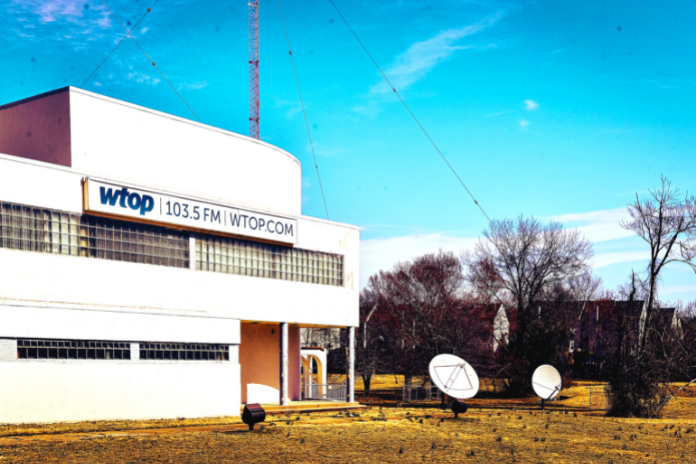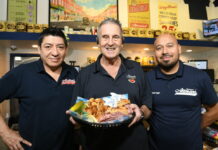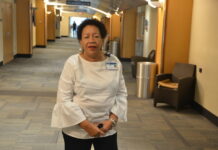
While Wheaton has its share of peculiarities and attractions — the longest escalator in the Western hemisphere, eateries that dish up everything from Peruvian chicken to Pad Thai — suburbs aren’t typically known for their stand-out architecture.
But there is a distinctive historic landmark: the WTOP (now WFED) transmitter building on University Boulevard.
The odd-shaped, concrete building that the Art Deco Society of Washington calls “unexpectedly urbane” sits on a patch of greenery within the shadow of three 350-foot towers supported by guy wires.
Designed by E. Burton Corning in 1939, the transmitter building represents later art deco, a pared-down version of earlier art deco architecture like the Chrysler Building in New York, explains Steve Knight, president of ADSW.
“The crisp lines … have more in common with a house by Richard Neutra in California or a building in the Weissenhof-Siedlung of Stuttart than with most of the other Deco in the city of Washington,” wrote Hans Wirz and Richard Striner in a Washington Deco article from 1984.
This design also incorporates international style, which is smoother and more streamlined. “It’s very bold, clean. There’s no ornamental frieze or decorative elements per se,” says Knight.
Popular in Germany and France — and rare in Montgomery County — international style marked a transition into the modern era of architecture. Knight, a principal at David M. Schwarz Architects in Washington, says the station might have picked this progressive design to symbolize that radio is the medium of the future.
“People will often think of ocean liners and trains. The thing is slicing through the wind. The prow is a very broad curve,” he says.
In order to appreciate the design, Knight suggests looking at the building from the bottom and moving horizontally.
“See the glass block. The grid is a material that gained a lot of prominence in the 1930s,” he says. “They were trying to get light in there but not necessarily to see in and out.”
Besides incorporating glass block for natural light, Knight says the building’s design was probably more about aesthetics than utility. The message the building sends is “simplification — celebrating the pure geometries, volumes and shapes,” he says.
The building has remained intact on the outside with no modifications, Knight says. He’s unaware of any past efforts to restore or renovate it.
Along with its distinctive exterior, the interior of the building reflects reverence for a bygone era.
The 50,000-watt transmitter sits in the same well that’s been used since the facility opened during World War II. A small studio overlooks the transmitter, and there’s a stash of vintage photos and equipment, archived by the late Granville Klink, the station’s chief engineer, who was considered the heart and soul of the operation.
Since Wheaton rests at one of the highest points above sea level in the Washington area, it drew other radio stations there as well. One of them, the old WGAY-FM/WQMR-AM, operated its studios and transmitters on Arcola Avenue, where the Kemp Mill Shopping Center sits today. On University Boulevard West, a few steps from famous Nick’s Diner, there’s still a single tower that once radiated the programming of WDON-AM and WASH-FM.
A testament to the significance of the WTOP Transmitter, President Franklin D. Roosevelt wrote in a letter to William S. Paley, president of CBS, after its completion that the building “symbolizes not merely the commendable development of your station, but of the entire broadcasting industry. And it symbolizes not merely the remarkable technical advance of the art, but also the ever-increasing contribution of radio to a better understanding of
public affairs.”
This story first appeared in the April-May issue of Montgomery Magazine.




